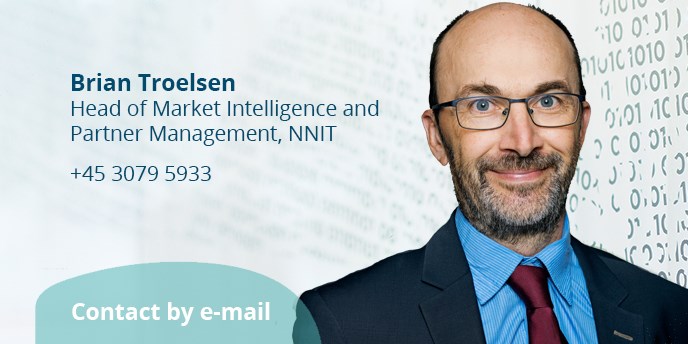Focus on data-driven sustainability
The responses to this year’s Expectation Barometer show that almost two-thirds of the respondents (63 percent) either agree or strongly agree that digital solutions are essential for them in realizing their sustainable goals. But how?
Brian Troelsen makes a couple of suggestions:
– The IT department is considered to be both a sustainability sinner and savior. Power consumption to support IT solutions represent a heavy CO2 footprint, but IT is also an important means of optimizing and streamlining business processes and workflows, he says, continuing,
– Digitization and IT make an important contribution to streamlining the value chain so that you can, for example, package things better for transportation, optimize space, and send them in the most sustainable way from A to B. It is enormously complex to optimize logistics, and IT can create great value in large data volumes and in the end lower C02 footprint.
Another recommendation is on the use of valid and verifiable data that can be used as a starting point for business initiatives to increase sustainability. Among other things, you can collect relevant data in a sustainability dashboard, providing an overview of different data such as power and electricity consumption, tracking the journey of your products through the value chain, the number of travel days, transportation costs, gender balance, sick leave – which are all important elements of running a sustainable business. A dashboard should off course not be limited to the C02 agenda, but include the relevant datapoints you want to measure and improve, be it diversity efforts, gender ambitions etc.
– It’s one thing to collect data, but it’s another thing to be able to get an intelligent overview, so that you can use the data to make smart decisions. With data, you’ll be able to answer questions about where you can make the most environmental savings most efficiently, where the low-hanging fruits are, and not least how the data supports strategic goals – and not the other way around, says Brian Troelsen, adding:
– It’s difficult to improve something you can’t measure. But with data on sustainability, you will be able to assess how far from your sustainability goals you are, and ensure that you can meet all stakeholder requirements for transparency and documentation.
Efficient workflows and less travel
Over half of the respondents (58 percent) to this year’s Expectation Barometer have the environment – including climate change and the depletion of resources – as their main sustainability focus.
– It’s not surprising that the environment is at the top. When working with IT, it is natural to concentrate on how it may play an intelligent role in reducing carbon emissions, Brian Troelsen believes.
An example of such a digital solution is Mixed Reality, which can streamline workflows and reduce travel for the organization. Technology can be used for remote support, auditing, or training sessions, making it possible to guide colleagues and employees from a distance.
Employees who are in the physical workplace wear HoloLens headsets and can interact with holograms and other objects while they have their hands free to do the work. With Mixed Reality, you can reduce travel, lowering environmental impact and creating flexible workflows, regardless of time and place.
Well-prepared IT contingency plans
Despite companies’ willingness and desire to make a difference to sustainability, respondents to this year’s Expectation Barometer point to a number of factors that could prove to threaten the organization’s resilience.
More than half of respondents (58 percent) believe that their inability to identify new risks and threats may be a hindrance to the organization, and around a third (34 percent) are concerned about the company’s current IT and security preparedness, while 28 percent of the respondents see indirect effects of climate change as a significant threat.
If we look at the figures on an industry level, we see that public sector companies in particular are more concerned about their current IT and safety preparedness than other sectors such as finance and life sciences. This may be due to the fact that the public sector is largely responsible for so-called critical infrastructure, where the effects of a crash or direct attack can have severe consequences for the entire society.
There is no doubt that a well-prepared IT contingency plan is key to operating a sustainable and resilient business – especially when we look at the turbulent events of recent years:
– The past couple of years have been a wake-up call for most of us, where various crises have raged – a pandemic, a war, a container ship blocking the Suez Canal and a large part of world trade, and a global climate crisis have shown us that even tomorrow has a short horizon, says Brian Troelsen, leading to his clear advice:
– Sit down together at least once a year and create a number of scenarios for the top 5-10 biggest threats that might hit you. What is the likelihood of the threats becoming a reality, and how can the IT department help put out the fire? The best insurance is to be well-prepared, explains Troelsen, concluding:
– It’s about making sensible and long-term decisions in advance. This ensures that you have a well-oiled IT contingency plan that will not only be activated when the crisis occurs, but will also prevent and anticipate potential threats and risks.

